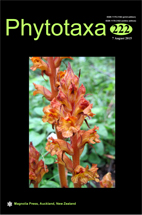Abstract
The orchid genus Gastrodia Brown (1810: 330) comprises approximately 50 species with a broad Old World distribution (Pridgeon et al. 2005, Cribb et al. 2010, Kenji 2014). Currently, there are at least 20 accepted species of Gastrodia recorded from China (Chung & Hsu 2006, Chen et al. 2009, Hsu & Kuo 2010, 2011, Yeh et al. 2011, Hsu et al. 2012, Tan et al. 2012, Hu et al. 2014). During our field surveys of Chinese traditional medicine in Huaping National Nature Reserve, Guangxi Zhuangzu Autonomous Region, China, a Gastrodia was spotted setting fruit in the past few years. Finally, we were able to observe it flowering in August 2014. After careful comparison morphological study with its close relatives (Averyanov & Efimov 2006) and three other species of Gastrodia recorded in Guangxi, namely Gastrodia damingshanensis A.Q.Hu & T.C.Hsu (2014: 256), Gastrodia elata Blume (1856: 174) and Gastrodia menghaiensis Z.H.Tsi & S.C.Chen (1994: 559), we confirmed this Gastrodia as a new species and thereby a new member to the flora of Guangxi. A detailed description, illustration and ecological information are presented below. We also discuss the remarkable dimorphic columns of this new species, which are documented in Gastrodia for the first time.

